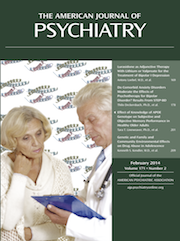The article by Kendler et al. (
1) in this issue of the
Journal reports the results of an extended twin-family study of drug abuse. Using a Swedish nationwide registry of twins and siblings, the authors were able to assemble a large, genetically informative data set. This data set was then linked with census, prescription, medical, and legal records to compile a listing of which individuals were likely to have drug abuse. Using this approach, the authors were able to model the family resemblance for drug abuse and estimate the contributions of genetic and environmental influences. The major findings of the study are that drug abuse is substantially heritable in both males (55%) and females (73%) and that shared environmental factors were present in males but not in females. Socioeconomic status and neighborhood deprivation both predicted drug abuse, and a substantial portion of the shared environmental influence on drug abuse was a community-wide, not household, influence.
While on one hand the article confirms findings from previous twin and adoption studies that drug abuse is highly heritable (
2–
4), it also represents a major methodological advance. Previous studies have all relied on twin or adoptee self-report, whereas this study used reports from population-wide registries and thus offers independent confirmation of genetic and environmental influences on drug abuse. While finding genetic effects strengthens the case for investing in studies aimed at understanding the molecular biological underpinnings of the genetic influences on drug abuse, the evidence for family- and community-wide influences on drug abuse are equally important. One problem that bedevils epidemiological studies of drug abuse is understanding the direction of effects. Do individuals or families with drug abuse suffer from “social drift” into a deprived environment, or does a deprived environment cause drug abuse (
5)? While the study by Kendler et al. cannot completely disentangle the direction of effects, the authors do demonstrate that above and beyond family-wide influences, there is a community-wide effect on drug abuse, suggesting that deprived communities exert an effect on the development of drug abuse. This suggests that community-wide prevention or intervention programs could ameliorate the development of drug abuse. The example of smoking rates declining through public health efforts suggests that declines in drug abuse could be achieved. On the level of family-wide effects, a finding of note is that years of cohabitation influence the risk of drug abuse, suggesting direct social transmission of drug abuse and a potential target for intervention or prevention strategies. This result should serve as a reminder to clinicians that when one member of a household is experiencing drug abuse, it places other members, particularly younger siblings, at risk (
6).
Another issue clearly demonstrated by this article is that the availability of large, integrated data sets available to researchers allows for important scientific advances to occur. This study utilized data on over 2.5 million individuals. While the Nordic countries have long been known for their well-developed integrated records system, it is unfortunate that the United States does not currently have similar capacities to conduct this sort of research, as is possible in Sweden. This is a critical public health issue, as both molecular biological as well as epidemiological studies will need large data sets in order to make substantial advances. While considerable media attention has been given to the issue of how private companies are collecting vast troves of data “donated” by users or how government-funded security apparatuses are collecting data, the absence of large-scale, integrated efforts on the United States public health side is striking. The advancement of understanding the social and biological influences on psychiatric disorders will almost certainly require studies on the scale of this project, if not larger.

